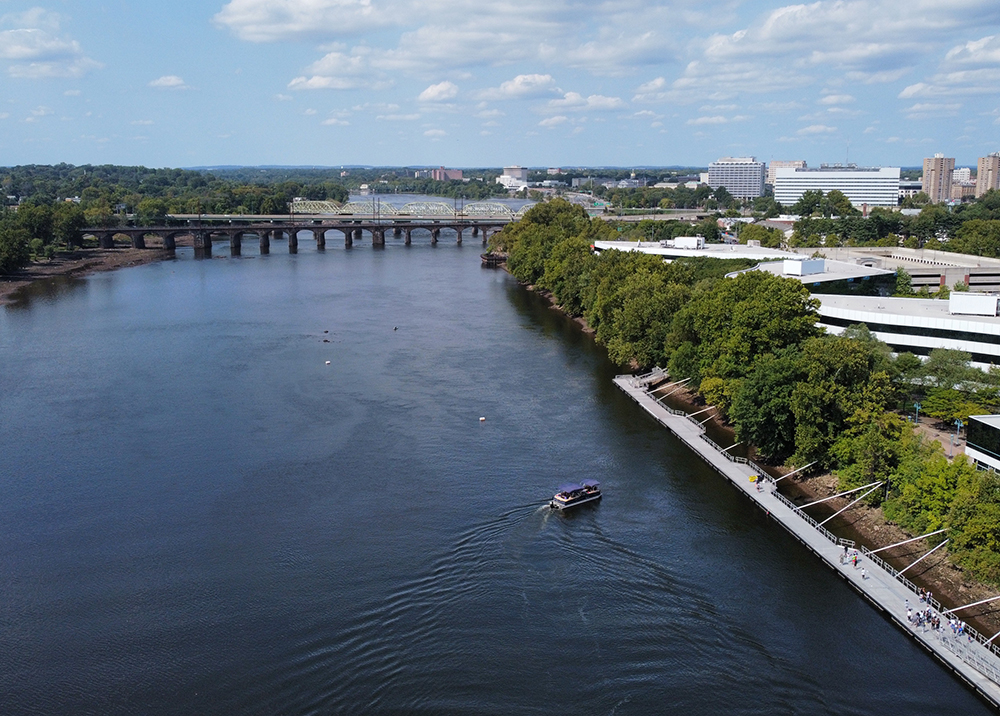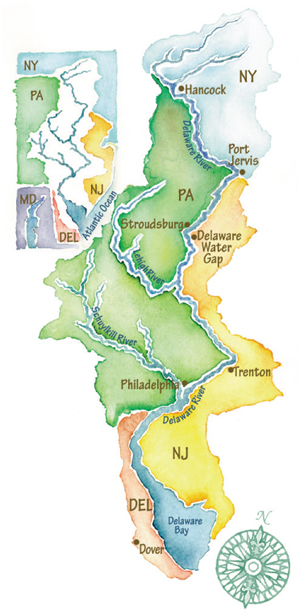Delaware • New Jersey • Pennsylvania
New York • United States of America
 The Delaware River at Trenton, N.J. Photo courtesy of The Watershed Institute. |
Before we talk about the Delaware River Basin, let's talk about the Delaware River
Free Flowing: It's the longest undammed river east of the Mississippi River
Border/Boundary: An interstate river its entire length; whenever you stand on one bank, you look across at another state
Length: 330 miles long; ~200 miles are non-tidal; ~130 miles are tidal
Headwaters: East and West Branch Delaware River confluence at Hancock, N.Y.
Mouth: Delaware Bay at Cape May, N.J./Lewes, Del. (where it meets the Atlantic Ocean)
Non-Tidal River: 200 miles from Trenton, N.J. north to its headwaters in N.Y.; clean, high-quality waters
• Part of DRBC's Special Protection Waters Program
• 75% in the National Wild & Scenic Rivers System
Tidal River: 130 miles from Trenton, N.J. south to the Delaware Bay; aka the Delaware River Estuary, where the river's freshwater mixes with the ocean's saltwater
• The Delaware River Estuary is part of the National Estuary Program, which protects estuaries of national significance; managed by the Partnership for the Delaware Estuary
• While the entire tidal river is part of the estuary, salinity levels vary from the Delaware Bay (saltwater) to Wilmington, Del. (brackish) to Philadelphia, Pa. and Trenton, N.J. (mostly freshwater).
• The tidal change also varies; in the Delaware Bay, the tidal change is about six feet, but in Trenton, it is about ten feet.
Tributaries: more than 2,000, incl. 216 major ones; largest are the Schuylkill and Lehigh rivers, respectively - both in Pennsylvania
A Clean Water Success Story
The Delaware River has come a long way from its polluted past in the late 1800s to mid 1900s, and its clean-up is hailed as one of the world's top water quality success stories.
• Historic Dissolved Oxygen Levels & Recovery
• The Clean Water Act: 50th Anniversary
Today, the Delaware River is cleaner and healthier, supporting numerous species of wildlife and millions of people. It supports a robust recreation/tourism economy and is home to the largest freshwater port in the world. It is proof that a living and a working river can coexist.
• Delaware River: American Rivers' 2020 River of the Year
• Migratory fish - for example, the American shad and the endangered Atlantic sturgeon - and resident fish are supported by the river; the upper Delaware is also a world-class trout fishery.
• Bald eagles reside or overwinter all along the river, surviving on fish as their primary food source
• Horseshoe crabs breed on the shores of the Delaware Bay more than any other place in the world
• Recreation & Tourism: Boating/paddling, fishing, birding and both land and water trails. The riverbank is home to numerous marinas, greenways and parks.
• Delaware River Port Complex (including docking facilities in Pennsylvania, New Jersey & Delaware): largest freshwater port in the world
→ Port Study (2017): 90 million tons of cargo moved through the regional ports, supporting over 190,000 jobs and over $85 billion in total economic activity (from a Maritime Exchange for the Delaware River and Bay 2018 news release)
→ Port Cargo: Includes petroleum and petrochemical products, container cargo, forest products and automobiles. It is the largest North American port for steel, paper and meat imports, as well as the largest importer of cocoa beans and fruit on the East Coast. Over 65% of Chilean and other South American fruits imported into the United States arrive at terminal facilities in the tri-state port complex. Wilmington, Delaware is home to the largest U.S. banana importing port, handling over one million tons of this cargo annually from Central America.
 |
What is a Basin? What is a Watershed?
A Basin is a large watershed; it is made up of smaller sub-watersheds. A watershed is the area of land draining to a particular stream. When it rains, the rain will absorb into the ground or run-off the land directly or via a storm drain into a waterway; both the waterway and the surrounding land make up the watershed. All of the watersheds that eventually drain to the Delaware River make up the Delaware River Basin.
The Delaware River Basin
Native Populations: Indigenous Peoples have lived in the Delaware River Basin for more than 12,000 years; the largest group was the Lenape. Other include the Nanticoke, Mohawk & Oneida.
• View Map of Native Territories (pdf)
Physical Geography: Includes 10 main sub-watersheds & five physiographic regions (Appalachian Plateau; Ridge and Valley; New England; Piedmont; and Atlantic Coastal Plain)
Area: 13,539 square miles in four states, plus the 782 square-mile Delaware Bay.
• Pennsylvania (6,454 square miles or 47.67 percent of the basin's total land area);
• New Jersey (3,009.5 square miles, or 22.23%);
• New York (2,395 square miles, 17.69%); and
• Delaware (979 square miles, 7.23%)
Counties & Municipalities: Includes 42 counties, and 836 municipalities; view information here
Land Cover: The northern part of the Basin is mostly tree canopy. The southern portion of the Basin includes more urban areas and farmland. As expected, more impervious surface (for example, paved roads) occurs in the more developed/urbanized sections of the Basin. Roughly 11% is wetlands - tidal and freshwater.
• View graphic of DRB land cover (2019; jpg)
• View graphic of impervious cover in the DRB (jpg)
Population Served: The DRB has a large size-to-service ratio; the Basin drains only four-tenths of one percent of the total continental U.S. land area, but 14.2 million people (~4% of the U.S. population; jpg) rely on its waters for drinking, agricultural and industrial use.
• Population Served by the Delaware River Basin (pdf; presented by DRBC staff, June 2023)
Water Use: Nearly 6.4 billion gallons of water are withdrawn from the Basin each day; this includes ground and surface water withdrawals for a variety of uses, the main three being thermoelectric power generation, public water supply and industry.
• The DRB supports the water needs of two of the nation's largest cities: Philadelphia and New York City, as well as ~one million people in northern New Jersey.
• Over 850 million gallons of water a day is used consumptively; this is water withdrawn from the Basin but not returned. The biggest consumptive users are out of Basin diversions for NYC and northern N.J., which total almost 2/3 of all water in the Basin that is used consumptively.
Economic Engine: Supports a water-based economy of over $20 billion dollars annually, from recreation, water quality, water supply, hunting/fishing, ecotourism, forest, agriculture, open space and port benefits; supports ~600,000 jobs.
Copyright © Delaware River Basin Commission,
P.O. Box 7360, West Trenton, NJ 08628-0360
Phone (609)883-9500; Fax (609)883-9522
Thanks to NJ for hosting the DRBC website